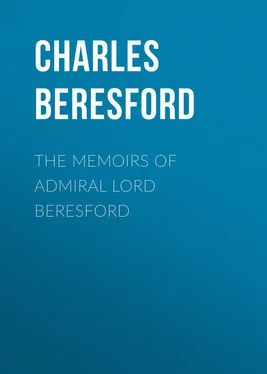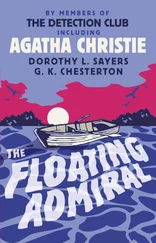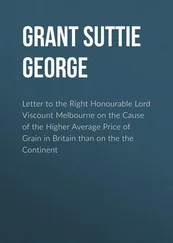Charles Beresford - The Memoirs of Admiral Lord Beresford
Здесь есть возможность читать онлайн «Charles Beresford - The Memoirs of Admiral Lord Beresford» — ознакомительный отрывок электронной книги совершенно бесплатно, а после прочтения отрывка купить полную версию. В некоторых случаях можно слушать аудио, скачать через торрент в формате fb2 и присутствует краткое содержание. Жанр: foreign_antique, foreign_prose, на английском языке. Описание произведения, (предисловие) а так же отзывы посетителей доступны на портале библиотеки ЛибКат.
- Название:The Memoirs of Admiral Lord Beresford
- Автор:
- Жанр:
- Год:неизвестен
- ISBN:нет данных
- Рейтинг книги:5 / 5. Голосов: 1
-
Избранное:Добавить в избранное
- Отзывы:
-
Ваша оценка:
- 100
- 1
- 2
- 3
- 4
- 5
The Memoirs of Admiral Lord Beresford: краткое содержание, описание и аннотация
Предлагаем к чтению аннотацию, описание, краткое содержание или предисловие (зависит от того, что написал сам автор книги «The Memoirs of Admiral Lord Beresford»). Если вы не нашли необходимую информацию о книге — напишите в комментариях, мы постараемся отыскать её.
The Memoirs of Admiral Lord Beresford — читать онлайн ознакомительный отрывок
Ниже представлен текст книги, разбитый по страницам. Система сохранения места последней прочитанной страницы, позволяет с удобством читать онлайн бесплатно книгу «The Memoirs of Admiral Lord Beresford», без необходимости каждый раз заново искать на чём Вы остановились. Поставьте закладку, и сможете в любой момент перейти на страницу, на которой закончили чтение.
Интервал:
Закладка:
In addition to the ordinary school curriculum on board the Britannia , the cadets were taught seamanship, gunnery and navigation. Book-work did not interest me, but I took great pains to become proficient in seamanship, in which I always secured a high place.
A cadet entering the Britannia under 14 years of age, would be rejected from the Service if he failed to pass the fourth quarterly examination after his entrance. Having entered the Britannia in December, 1859, I was sent to sea in March, 1861. I was very happy during my time in the Britannia . Out of school time, we did a great deal of boat-pulling. My boat was called the Gazelle . I remember that one day, when I borrowed a private boat to put off to the Gazelle , my comrades pushed me out into the stream, and I drifted out to Spithead, without oars. There was nothing in the boat but a painter, which I considered it to be my duty neatly to coil down. Then I sat still and waited until a boat came to fetch me.
Seamanship was taught by the use of models, and sail-drill was taught upon the mizen-mast. I remember being haunted by a doubt lest the handling of small models, and going aloft in a stationary ship, might not enable me to practise the knowledge thus acquired when I came to deal with the real full-size objects and to go aloft in a ship at sea. My prevision was largely justified; and when I came to command a ship, I made the youngsters learn their business by handling real things and not the models of them. For if anything goes wrong while teaching a youngster, for instance, to lay out a 6-ton anchor upon a model, he puts it right with his finger and thumb and thinks he can do the same with the real anchor.
The captain of the Britannia was Robert Harris, to whom the Service owes the inestimable benefit of cadet training ships. The first lieutenant was George S. Nares (now Vice-Admiral Sir George S. Nares, K.C.B.). He commanded the Challenger in her voyage of scientific discovery of 1872, during which he was recalled to proceed upon his celebrated voyage of Arctic exploration. Another lieutenant was William H. Heaton, whose long whiskers afforded the cadets much innocent amusement. On a windy day his whiskers used to stream backwards over his shoulders. Lieutenant Heaton chose to wear his stripes running longitudinally up his arm, a peculiarity which exemplifies the prevailing latitude with regard to uniform. There was no rule prescribing the pattern of cap or great-coat worn in the Service. Officers might wear the mohair band and badge on any kind of cap that took their fancy. Some of them used to transfer plain clothes buttons to a uniform coat or greatcoat, if they were going ashore, for the sake of economy; for we were nearly all poor in those days. The chaplain and naval instructor was the Rev. Robert M. Inskip.
My chest on board the Britannia stood between the chests of poor "Andy" Wauchope and Henry John Thoroton Hildyard. Both subsequently left the Navy for the Army. The late Major-General Andrew Gilbert Wauchope, D.S.O., was fatally wounded at Magersfontein during the South African war. General Sir Henry J. T. Hildyard, G.C.B., K.C.B., retired in 1911, after long and distinguished service. I was strongly inclined to follow the example of my comrades and to join the Army; and I have since occasionally regretted that I remained in the Navy, in which Service there is less opportunity for attaining the highest rank.
I was raised to the rank of "captain" in the Britannia ; but I regret to say that my enjoyment of that dignity was singularly brief, for I was disrated upon the same day, even before I had time to put on the stripe. For my delight at my promotion so exhilarated me, that I forgot to resist the temptation to empty a bread-barge upon the head of the old master-at-arms as he was coming up the hatchway, and the spectacle was so amusing that I stayed to laugh at it.
When I entered the Service, the system of training young seamen, as well as cadets, was in operation. To Sir James Graham, First Lord of the Admiralty, is due the credit of introducing the training of seamen. In 1854, he caused the Illustrious , two-decker, to be commissioned for that purpose, under the command of Captain Robert Harris. The fact was that as sails gave place to steam and as the science of gunnery progressed, it became necessary to enter seamen as boys and to train them for continuous service. For some time the short service and long service systems were concurrent. When I went to sea, captains still entered men direct from the merchant service, and very good seamen they were. They were engaged for a commission, at the end of which they could re-engage or not as they pleased. But in the meantime, under the admirable administration of Captain Harris, "Jimmy Graham's novices," as they were called, earned an excellent reputation in the Fleet; and continuous service gradually replaced intermittent service. In the continuous service system resided our chief superiority over foreign Navies. The objection to it on the part of the Government was (and is) the increasing permanent charge of pensions. But in the interests of the Service and of the country, it cannot be too clearly understood that the system is well worth the cost, and that the revival of the short service system is profoundly to be regretted.
H.M.S. Britannia . – She was the seventh ship of her name. She was launched at Plymouth in 1820, was pierced for 120 guns, and her complement was 900 men. Her length, beam and draught were 205 feet, 53 feet and 18 feet respectively. In the Crimean war, she landed 200 men as part of the naval brigade which assisted the Army at the siege of Sevastopol, and took part in the bombardment of that town. She was commissioned on 1st January, 1859, by Captain Robert Harris, as a training ship for cadets. The Britannia was stationed first in Portsmouth Harbour, then at Dartmouth. She was broken up in 1869. The memory of Captain Robert Harris deserves to be held in high honour. Vice-Admiral Sir William Fanshawe Martin, who himself achieved great reforms in the discipline of the Fleet, while in command of the Mediterranean Fleet, wrote to Captain Harris under date 18th January, 1861, "There is no man in England whose opportunity of doing good to our country for ages to come is greater than yours; and assuredly the Navy is greatly your debtor." ( The Story of the Britannia , by Commander E. P. Statham, R.N. Cassell.)
The successor of the Britannia in which Lord Charles Beresford received his training, the eighth of her name, known and remembered with affection by all naval officers save the new generation, lay at Dartmouth for more than forty years, when her functions were transferred to the colleges on shore. ( The King's Ships , by H. S. Lecky, Lieut. R. N. Muirhead. Vol. 1.)
CHAPTER III
THE SHIP OF HAPPIEST MEMORY
On the 25th of March, 1861, I was appointed naval cadet in the Marlborough . As I climbed up her side by the hand-rungs, while my chest was being hoisted in over all, I perceived two huge men looking down upon me, and I heard one say to the other: —
"That white-faced little beggar ain't long for this world, Dick."
The speaker was John Glanville (called Clamfy Glanville), boatswain's mate (of whom more anon), and he addressed this lugubrious remark to Dicky Horne, the quartermaster, a very fat man. It was a far from encouraging welcome to the sea; but the fact was that I had been ill, and was feeling very cold as I climbed up the side of the ship. At first, I was much disappointed at having been sent to a large ship, for we youngsters had a notion that there were more freedom and independence in a small ship; and besides, I wanted to go to China. But I went to China all in good time.
Читать дальшеИнтервал:
Закладка:
Похожие книги на «The Memoirs of Admiral Lord Beresford»
Представляем Вашему вниманию похожие книги на «The Memoirs of Admiral Lord Beresford» списком для выбора. Мы отобрали схожую по названию и смыслу литературу в надежде предоставить читателям больше вариантов отыскать новые, интересные, ещё непрочитанные произведения.
Обсуждение, отзывы о книге «The Memoirs of Admiral Lord Beresford» и просто собственные мнения читателей. Оставьте ваши комментарии, напишите, что Вы думаете о произведении, его смысле или главных героях. Укажите что конкретно понравилось, а что нет, и почему Вы так считаете.












